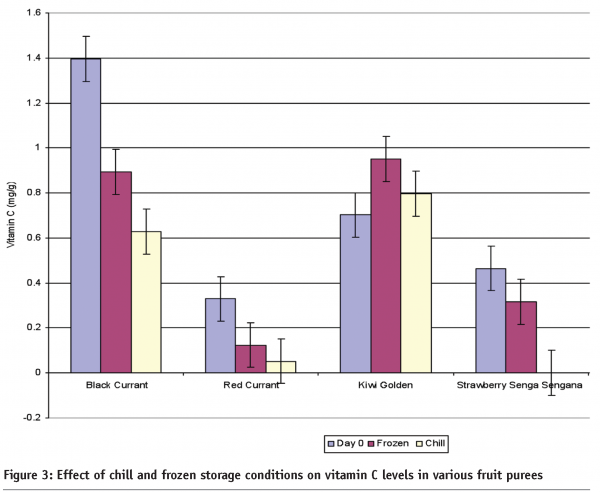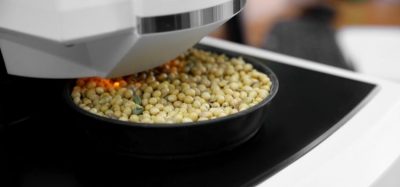A new generation of natural and nutritious pleasure-foods
- Like
- Digg
- Del
- Tumblr
- VKontakte
- Buffer
- Love This
- Odnoklassniki
- Meneame
- Blogger
- Amazon
- Yahoo Mail
- Gmail
- AOL
- Newsvine
- HackerNews
- Evernote
- MySpace
- Mail.ru
- Viadeo
- Line
- Comments
- Yummly
- SMS
- Viber
- Telegram
- Subscribe
- Skype
- Facebook Messenger
- Kakao
- LiveJournal
- Yammer
- Edgar
- Fintel
- Mix
- Instapaper
- Copy Link
Posted: 18 August 2008 | Joy Wilkinson, Mark Berry, Peter McClure and Susie Turan, Unilever Plc | No comments yet
Key driving forces for new foods are naturalness and nutrition. Consumers also expect pleasurable eating experiences. Unilever have recently launched “Frusi” , a completely new concept in ice cream that addresses the ‘enjoyment versus health’ paradox – the idea that something that tastes good cannot be healthy and vice versa. Moreover, Frusi is the first of a new generation of natural and nutritious pleasure-foods that is eaten directly from the freezer.
Key driving forces for new foods are naturalness and nutrition. Consumers also expect pleasurable eating experiences. Unilever have recently launched “Frusi” , a completely new concept in ice cream that addresses the ‘enjoyment versus health’ paradox – the idea that something that tastes good cannot be healthy and vice versa. Moreover, Frusi is the first of a new generation of natural and nutritious pleasure-foods that is eaten directly from the freezer.
Key driving forces for new foods are naturalness and nutrition. Consumers also expect pleasurable eating experiences. Unilever have recently launched “Frusi” , a completely new concept in ice cream that addresses the ‘enjoyment versus health’ paradox – the idea that something that tastes good cannot be healthy and vice versa. Moreover, Frusi is the first of a new generation of natural and nutritious pleasure-foods that is eaten directly from the freezer.
Traditionally, freezing was used as a process for food preservation, preventing the unwanted growth of spoilage and pathogenic microorganisms; particularly for providing a convenient source of vegetables, meat and fish to consumers who lived in locations remote from the sites of harvest and slaughter. Freezing has also been used to create pleasurable eating experience: principally in the form of ice cream – which was served as a delicacy to the aristocracy as early as the 17th century (Clarke, 2004). In more recent times, the effects of freezing on the preservation of nutrient content have been investigated. Frozen foods are sometimes perceived to be nutritionally inferior to fresh foods but in reality, frozen foods have their nutrients “locked-in” and are less susceptible to loss during storage. For example, frozen peas were found to maintain a higher vitamin C content for longer periods than the equivalent fresh product.
More recently, a new food has been designed that combines all three of these benefits of freezing: preservation of natural ingredients, maintenance of nutrition content and a pleasurable eating experience. In 2006, Unilever launched “Frusi” which is a product made from wholegrain cereals, frozen yoghurt and frozen fresh fruits (see Figure 1). Each pot contains three layers: the base is made from a mixture of wholegrain oats, biscuit pieces and caramelised cashew nuts; this is topped with frozen yoghurt followed by a layer of fresh frozen fruits. A final glaze containing a concentrated juice derived from Acerola cherries is applied. Frusi is currently available in three different flavours and can be enjoyed as part of a healthy balanced diet, as one pot contains 2.4 grams of fat, a maximum of 110 calories and 50 per cent RDA vitamin C.
In this article, we discuss how the freezing process delivers benefits of retaining nutrients and assuring food safety (see Berry et al, 2008 for a recent review of this subject). We use Frusi as an example to illustrate these benefits in practical terms.
Benefits of freezing for retaining nutrients
Contrary to popular belief, ice cream has a number of advantages in delivering a nutritious and healthy snack. It is frozen and therefore maintains nutrient stability; freezing acts as a natural preservative; it is generally served in specific portion sizes so that a measured amount of nutrient can be delivered; and it remains well liked by children and adults; and key ingredients used in ice cream include milk and fruit, which provide a number of health benefits.
Milk is a product used to sustain mammals from birth and as such it provides all the components required for life, including a range of vitamins and minerals, fats, sugars and proteins. It is a key ingredient in ice cream where it contributes to the dairy flavour, and serves a key role in stabilising water-continuous emulsions and foams resulting in air bubble stability (Clarke, 2004). In Frusi, milk is the main ingredient of the central yogurt layer which is made extra-creamy by a new process of homogenisation under high pressure – also known as “double-churning”.
The microbiological safety of milk is achieved through pasteurisation using standard conditions of heating to 72°C for five minutes. Ice cream mixes are also pasteurised, though conditions differ and heating at approximately 80°C for 15-20 seconds is commonly used to assure microbiological safety. A comparison of the pasteurisation process used in the making of ice cream with that used to treat milk reveals that nutrient losses are smaller during ice cream pasteurisation. The pasteurisation of milk results in 20-30 per cent loss of vitamins A, E and B2, while corresponding losses from ice cream pasteurisation are less than 10 per cent (see Figure 2). Following pasteurisation, storage of milk at either frozen or chill for a number of weeks results in no further loss of nutrients. This contrasts with the freezing of unpasteurised milk, in which loss of some nutrients is thought to be due to continuing enzyme activity.
Fruit provides a range of sugars, vitamins, minerals, polyunsaturated fatty acids, fibre and a range of phytochemicals, but its most significant nutrient, particularly in terms of processing losses, is vitamin C. All plant materials, including fruit, continue metabolic activity following harvesting which may result in some loss of quality, including a deterioration in nutritional quality. This activity can be minimised through rapid processing, including freezing.
Vitamin C in fruit is susceptible to oxidation through the action of ascorbic acid oxidase (AAO). Ascorbate, which is concentrated in the cytoplasm of the cell, does not normally come into contact with AAO which is sequestered in the extracellularly. However, processing activities that cause tissue damage such as bruising, wilting, slicing, juicing and pureeing allow AAO to come into contact with ascorbate which is subsequently oxidised. Ascorbate loss is rapid but can be minimised by freezing immediately following the processing step (see Figure 3). In this respect, vitamin C is retained more extensively in a frozen product than in drinks such as juices and smoothies.
The oxidation of ascorbate through AAO can be prevented by heat treatment. However, in the case of fruit, this would result in unacceptable losses to texture and appearance, important attributes in products such as ice cream. The approach in Frusi is to use whole fruits and pieces in the product combined with a heat treated Acerola glaze to ensure each product contains 50 per cent of the RDA for vitamin C. Once the action of AAO is minimised, vitamin C in ice cream is very stable to ice cream processing and frozen storage (see Figure 4). Ice creams therefore provide an ideal way of delivering this nutrient.
In addition to vitamin C, fruit provides a range of antioxidants and these are susceptible to oxidation on storage. For example, b-carotene, found in fruits such as mango and apricot, degrades in chill storage to a much greater extent than when stored at frozen temperatures (see Figure 5). Freezing will therefore ensure that higher overall levels of b-carotene are retained in a product such as Frusi compared with products stored at chill temperatures including smoothies and yoghurts.
As well as milk in the form of yogurt, and fruit, Frusi has a muesli base consisting of a mix of nuts, seeds and cereals. From a nutritional perspective, the benefits of freezing to these types of ingredients have not been widely investigated. However, nuts and seeds with high oil contents may be prone to oxidation of the oil component, leading to rancidity and the generation of off-flavours. It is anticipated that freezing will slow the rate of oxidation and so allow longer storage times for nuts and seeds.
Benefits of freezing for assuring food safety
Freezing is an extremely effective preservation technique that inhibits the metabolic activity of microorganisms associated with foods, preventing their growth and ability to form toxic by-products, providing the temperature is low enough, for example below -10°C. Microorganisms vary in their survival capabilities and many are able to survive freezing conditions for long periods, retaining their ability to multiply when conditions become more favourable. For some microorganisms such as protozoal parasites (such as Cryptosporidium spp.) and nematodes, freezing is an effective means of killing. For other types of organisms, freezing may simply stop their ability to multiply and thereby reduces risk. The key concern for food safety is to prevent pathogens being present at levels that can cause harm and for low infectious dose organisms, this often means that they must be absent at the point of consumption.
From a microbiological perspective, the three main components of Frusi have different requirements for safety. While the cereal component provides a rich source of nutrients (for example, vitamins, carbohydrates, minerals) that can in principle be utilised by microorganisms, the reduced water activity prevents the growth of most microorganisms. In addition, heat treatments commonly applied to cereals effectively destroy pathogens in processed products. As a consequence of these and good hygienic/manufacturing practices, outbreaks of foodborne disease associated with cereal products are uncommon and this has led to this group of products having an excellent safety record. Yoghurt also has an excellent safety record, being dependant on the pasteurisation of milk to destroy infectious agents and fermentation to reduce the pH to levels that effectively prevent the growth of spoilage microorganisms during subsequent shelf-life at refrigeration temperatures.
For fresh fruit, there are few intervention techniques that can be applied to destroy infectious agents that may be present because of the damage caused to the fruit. Washing can remove low levels of microbiological contaminants (Bassett & McClure, 2008) but is unsatisfactory as a control on its own. Because of this, the main control measures rely on preventing contamination of produce during cultivation, harvesting and handling. Assuring microbiological safety and quality of fresh fruit is provided by good agricultural practices (GAP): avoiding the use of contaminated manures, contaminated irrigation water and other materials; not using dropped or windfall fruit and proper handling on the farm combined with effective processing and handling at packinghouses prior to freezing. The greatest risk is posed by contact with contaminated materials coming from farm or wild animals and / or poor hygiene of workers in the field or those involved in peeling / slicing fruit before further processing. Although there have been a number of outbreaks of foodborne illness associated with (fresh frozen) fruit consumption, application of GAP, Hazard Analysis and Critical Control Point (HACCP) technique and ‘prerequisite’ programmes are able to provide adequate measures to assure safety.
For Frusi, much of the focus for safety is therefore placed on the fresh fruit: we source it from approved suppliers able to provide evidence that their safety management systems are working effectively, and when these raw materials are received, we use careful handling, good hygienic practice and good temperature control.
Conclusions
Freezing delivers the benefits of both retaining nutrients and assuring food safety. These benefits can be packaged into a convenient, nutritious and pleasurable food product such as Frusi which delivers a number of advantages when compared with other similar but non-frozen foods. Fresh fruit has the strong consumer appeal of naturalness and health and yet is often considered inconvenient by consumers. For example, a significant proportion of fresh fruit bought as part of a weekly shop will have deteriorated due to food spoilage organisms by the end of the week. This can result in wastage, which is costly both to the consumer but also to the environment. By contrast, a frozen product like Frusi can have a shelf-life of two years. In comparison with nutritious chilled products (such as smoothies or yoghurts), Frusi again compares favourably. Chilled products are labelled on the basis of nutrients added and the shelf-life is determined by their microbiological stability (typically one to three weeks). However, by the end of this period, many of the nutrients will have reduced significantly in content due to chemical reactions (such as oxidation). In contrast, in a frozen product, the nutrient content is guaranteed for much, much longer as illustrated in this article and in a recent book chapter (Berry, McClure, Fletcher, Wilkinson 2008).
Frusi addresses the ‘enjoyment versus health’ paradox – the idea that something that tastes good cannot be healthy and vice versa. Moreover, Frusi is a “platform”, a whole new concept on which we have great potential to build a whole new generation of foods that are both healthy and pleasurable to eat.










References
Berry, M., Fletcher, J., McClure, P. and Wilkinson, J. (2008) Effects of freezing on nutritional and microbiological properties of foods. In Frozen Food Science and Technology, ed. J.A.Evans. Blackwell publishing, Oxford.
Bassett, J., McClure, P.J. (2008) A risk assessment approach for fresh fruits. Journal of Applied Microbiology, 104, 925-943.
Clarke, C. (2004) The Science of Ice Cream. Cambridge: The Royal Society of Chemistry.









